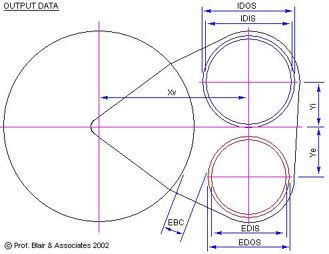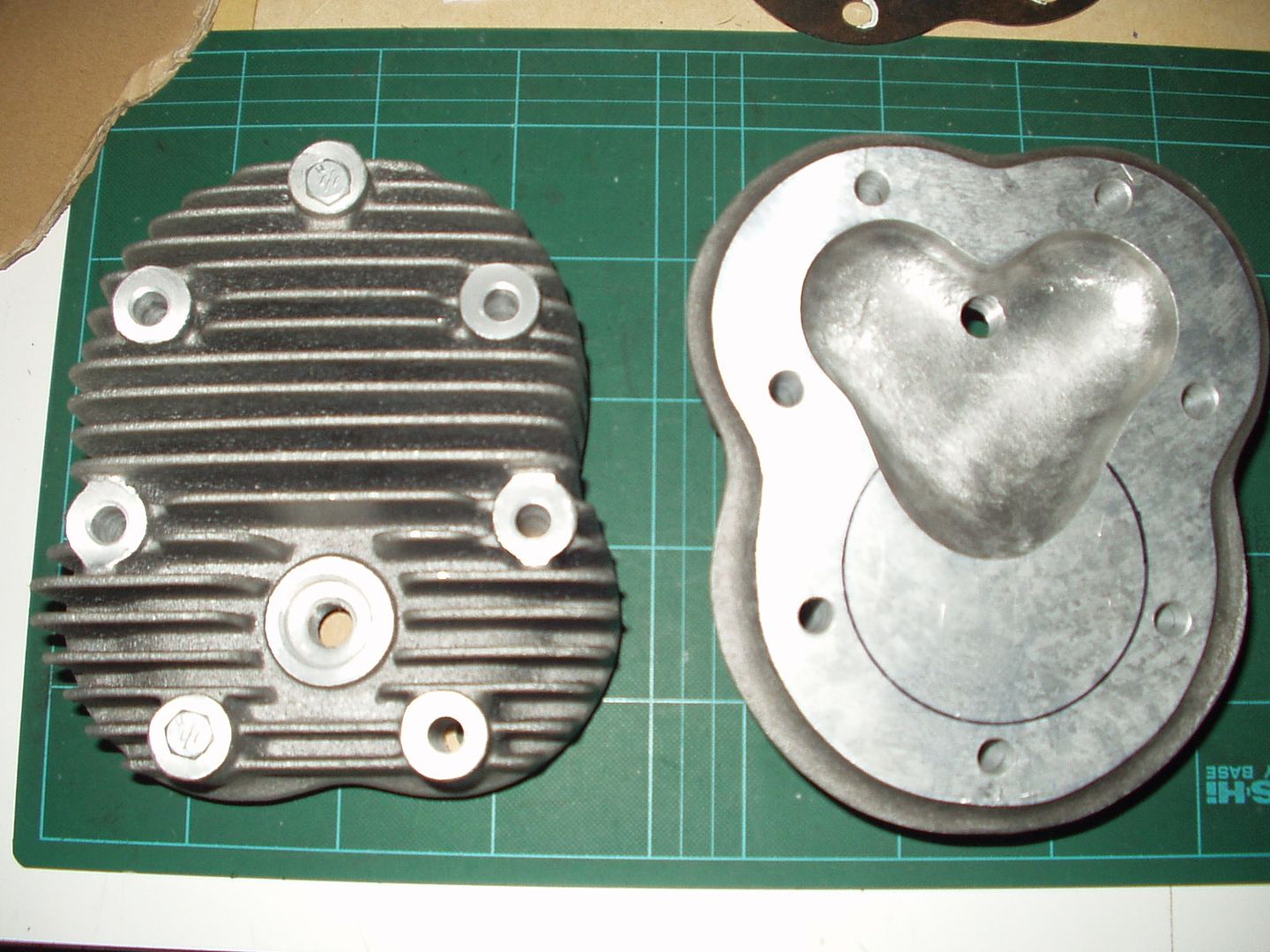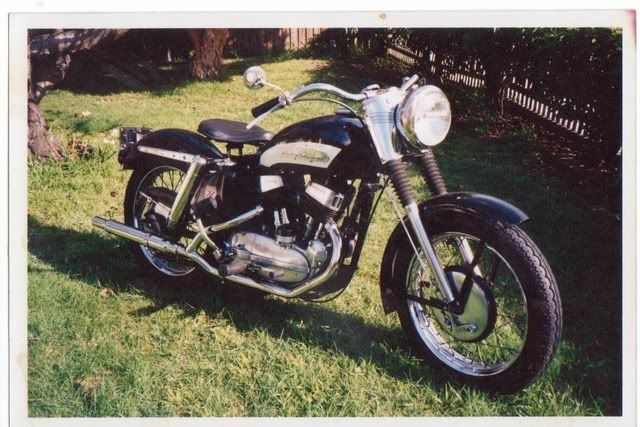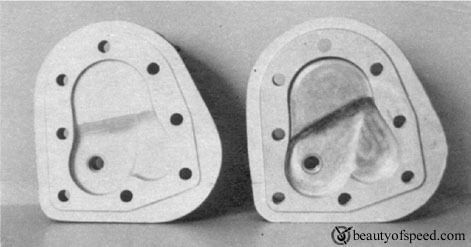Having owned M20s for over twenty years now I think now a little bit about them.
I recently acquired a very rough civilian 1955 m20,but the engine had been rebuilt using a goldie big end!
I thought about tuning it but all the pundits said its not worth the effort,
so I set about to prove them wrong,here is what I did.
Gas flow barrel,machine top so piston has 15thou clearance,reshape valves,
radius top of bore towards valves and fit 1"1/16 amal.
this made a massive difference,top speed only up a few MPH but acceleration much improved,quicker than M21 and hillclimbing much better.
Then one year on I got hold of a spare cast iron head and welded up 1/3 of the combustion space using nickel arc welding rods,then made a cylinder head gasket using .6mm solid copper,and fitted a 389 amal.
This made another big improvement on acceleration and hillclimbing,although I had to retard ign a bit to release the extra power.Now it was Quicker than B33s and most singles.
Later on I got hold of some gold star scramble cams that had been modified to suit side valves(almost always open)
had to set gaps at 15 and 20 to get compression and boy what a difference its a mental machine!
Still starts easily and sounds like a sidevalve until you open the throttle and it flys and even sounds like a goldie! Top speed is in the eightys and acceleration is about 10 secs to 50.
cost of work was about £200.all machining and welding done by myself.
My military M20 I have left standard apart from a bit of welding up of the combustion space to bring compression up to nearly 6-1 this makes hillclimbing a bit better and runs a lot cooler,but I can still cook a meat pie on top of the head in about 40 miles!
P.S forgot to mention after fitting cams also fitted a set of inner valve springs to raise revs.
email (option): barryrapley@sky.com
Sounds great :D... nice to experiment but also have a standard one to do direct comparisons.
The first Goldie's did have the same big end as the M20.
did you do alot of weight reduction on the bike ?
Can you confirm what clearance you are running between the underside of the head and the top of the piston (with the gasket fitted) and what the compression ratio is after modification?...Ian
email (option): ian@wright52.plus.com

15thou plus .6mm copper gasket,comp ratio approx. 6-1 bore std size
ps. weight reduction only me, as been on a low calorie diet,bike remains std.
email (option): barryrapley@sky.com
Sounds the business mate! I don't suppose you took any photos of things as you went along did you? It would be good to see what you did, for those 'non-engineers' among us :-)
Baza, was it you who did Sean's head, as featured in this month's 'Real Classic' ?
What was that about Rik..?...Ian
email (option): ian@wright52.plus.com
the answer to that is ..yes,i did weld up shauns head!%%bbCodeItem_1%%.
this is a picture of head before and after.
email (option): barryrapley@sky.com
Have you tested the "hot" engine for cranking pressure? I'd be curious to know what effect those cams had on 6:1 static compression ratio.
My Excel W/S for the M20 geometry (revised for the stock data) show the following guesses at intake valve closing position with 6:1 nominal CR.
Standard 2420 with 65° IVC = 89 psi (with the std. 4.9:1 CR it's 67 psi)
Touring 2448, 73° IVC = 81 psi
DB32 Scrambles 2454, 70° IVC = 84 psi
DBD Scrambles 2446, 72° IVC = 82 psi
CB32 Scrambles 2444, 85° IVC = 68 psi
Now some guesses at low speed power - torque at 1,000 RPM
Standard 2420: 12.4 ft/lbs. (with std. 4.9:1 CR it's 8.8 ft/lbs.)
Touring 2448: 10.2 ft/lbs.
DB32 Scrambles 2454: 11.0 ft/lbs.
DBD Scrambles 2446: 10.4 ft/lbs.
CB32 Scrambles 2444: 7.1 ft/lbs.
Question: why are the gauge pressures of the stock cam and the hottest cam (2444) so similar at 67 psi and 68 psi, but the torque is much lower at 8.8 and 7.1 ft/lbs?
This is where DCR leads the reader astray. The lower torque is because the same 67 or 68 psi pressure is acting on a much smaller cylinder, with only the volume after 85 ABDC vs. 65 ABDC actually trapped.
email (option): sales@victorylibrary.com
f,.k me Panic lad,now you,ve blinded me wiv science...cant answer that,all I know is that it works, and shaun,aka kent correspondant and other members of VMCC will confirm that this works and I have done 750 hi speed miles with no problems..in fact I have just changed engine sprocket from 19 tooth to 21 tooth and cruising speed is great, plus mpg approx. 55 although acceleration on hills is not so good,so if you want drag race acceleration,stick with 19 tooth or go for sidecar gearing 16 tooth...outdrag an R1 up to 20....!
email (option): barryrapley@sky.com
this is the tuned 1955 M20.
%%bbCodeItem_1%%.
and this is my Wm20 with slightly raised comp ratio.
%%bbCodeItem_2%%
email (option): barryrapley@sky.com
If you're using the scrambles exhaust cam you might find the stock 2420 exhaust an improvement, or the 2438 OHV exhaust cam (282°, 65-37). It still adds 12° overlap (over the 2420) but also retains much more of the duty cycle than the hotter OHV exhaust cams.
Qua, you say?
The long exhaust duration is needed in a GS etc. because the intake port is so good, which makes for higher exhaust volume. This needs a long interval to both evacuate the chamber, and reduce residual pressure to minimize pumping loss.
The M20 has far less to expel, and can get by very nicely with only slightly more than the original exhaust cam.
Apology in anticipation: if I seem somewhat glib on technical stuff, it's because my dabbling with sidevalve engines began in 1968.
email (option): sales@victorylibrary.com
Here's a question for you Panic...Can you tell me at what revs the late K model Harleys produced maximum power..? It seems to me that with the carb and port sizes etc. employed they were probably revving them well, but I don't have the figures.....Ian
email (option): ian@wright52.plus.com
Or I should say late KR Models....Ian
email (option): ian@wright52.plus.com
The 1952-53 K (street) models inherited much detail from the latest WR race engines, inclusing huge intake ports (1-9/16"), big carburetor (1-9/16" throttle with 1-1/4" venturi), large intake and small exhaust valves, and strong rods, although the cams were mild. CR was 6.5:1. Power: about 32 HP @ 6,000+ RPM.
The 1953-* KR engines had far more cam timing, with other mods added during development (even bigger rod set, modified breather, low volume oil pump). Power for the conventional (long rod, single carb) KR: about 52-56 with RPM over 7,000.
The last (short rod, dual carb) 1968-69 KR was about 60 HP.
Long rod = 7-7/16" centers, the same for all 45, 54 and 61" 4-cam motors 1929-85 regardless of stroke length (exception: XR1000 rods were 6.92", also used 1986-* on all Evo Sportsters).
Short rod = 6-7/16" centers, hand-made by sawing a 1" section from the middle and welding it back together, only used on special "low boy" KR engines. A real (not modified) rod in this length was also used on XR750 motors 1970-*.
IMHO the K engine isn't suitable for directly transposing dimensions or specs to the M20. That CR is made possible by having the valves right new to the bore, the intake port size would require a fabricated insert.
The KR intake/exhaust bias is pretty big; the exhaust cams were mostly 30° shorter than the intakes. My guess: the M20 will tolerate even more intake than the K (30°+) because:
1. it's bigger
2. smaller ports means higher gas velocity = less reversion
email (option): sales@victorylibrary.com
Thanks for the info...I agree about direct transfer of spec...Not possible. Basically I just wanted to confirm my suspicions about the upper rev limits...
My M20 sprinter engine is extremely modified, to the extent that 'normal' criteria for that engine largely no longer apply. It a 'one off' 600cc motor (but not an M21) with more or less everything altered to a much more radical spec....
Regarding the sidevalve Harley race engines I just think they are great looking and very interesting, with a fascinating history that involved some of the great American 'engine men'...
Unlikely I'll ever own one unfortunately..I'll just have to make do with my Sportster...
I remember watching Cal Rayborn racing the factory bike in the 'Tranatlantic Trophy' here in the UK back in the early 70s...Ian

email (option): ian@wright52.plus.com
I'm not too clear on the geometry of the M20 chamber, specifically the contour in the head for the dome? Is that small crescent behind the dome relief a quench surface?
I suspect BSA was stuck with "as-cast" heads (except for the gasket surface) as far as the interface between the dome and head, where the quality of fit isn't really precise but machining too $$$. That looks like an area where volume may be effectively trapped by the dome (opposite the valve side), and not burn at a useful time.
email (option): sales@victorylibrary.com
Thanks for posting the photos Baz, much appreciated. It looks as if I am going to have to learn how to weld 
 Duncan
Duncan
Part of the (flat) M20 piston is covered by the head in 'Ricardo' fashion to provide a 'Squish' area (Quench area?)...The squish clearance between the head and piston crown can't be tied down too tightly statically because of the inherent 'flex' that is present in the crankshaft assembly when the engine is running...In practice a static clearance of .030"-.040" (including gasket) will result in the squish functioning within effective limits once everything gets running. A 'super tight' squish area would be nice but an alternative, stiffer crank assembly would be required to achieve this..
Earlier engines (1936-37 M20s) actually had a better, more compact, combustion chamber but the barrel had the tappet chest cast directly onto the side of the cylinder. This increased the tendency for bore distortion through uneven heating, so an air gap was introduced between the tappet chest and the cylinder...All good but the price was a widening of the crankcase and barrel to accomodate this and a consequent widening of the combustion chamber (along with moving the valves away from the cylinder)...Not so good from the combustion point of view. However, the M20 wasn't a race engine (it was a low powered workhorse) so I suppose they thought better cooling was a good trade off for a small decrease in combustion efficiency..
Also, even at this stage, development of side valve motors had largely ceased a number of years before and they might not have appreciated the full practical effects of this change.....Ian
email (option): ian@wright52.plus.com
Is that the AJS equivalent of the Model X from the late 30's?..and is the internal layout of the new heads the same as the original heads?..Very nice KH...Ian
email (option): ian@wright52.plus.com
Here's Blair's layout from his (expensive) sidevalve program. Note how relatively narrow the transfer area is at the bore edge, and how small the area inside the bore is compared to many existing designs.

email (option): sales@victorylibrary.com
Hi Panic..By 'transfer area' I guess you are referring to the distance of the valve from the edge of the cylinder?....In my engine that dimension is approx. 1/8" on the inlet side after modifications, so no room for 'reliefs' in the cylinders top face...
There is indeed a lot of 'Squish area' in the Blair layout..A section through the combustion chamber instead of a plan view would be interesting to see how much 'depth' there is in the head and what the profile of the chamber roof is like...I see he doesn't appear to come from the 'space round the inlet valve' school of sidevalve tuners either...or indicate a spark plug position.
The more I look at this the more I wonder if it meant to be a layout drawing of an actual engine or just one that covers 'basic principles'...Ian
email (option): ian@wright52.plus.com
I didn't see a disclaimer, but I assume that the drawing's proportions are not correct for any specific engine.
The valves are shown elsewhere as parallel to the bore axis (like the M20, but unlike the KR, Ford, Hudson etc.).
That entire chamber section (other than the transfer) is quench, and flush with the cylinder deck with no pop-up or dome intrusion.
The narrow angle of the transfer follows Ricardo's original remarks that this area between the valves and the bore must be constrained to about 1/2 its X-area; it's one of the patented features. In the KR it appears that this is done by lowering the roof. Unfortunately, the patent claim reveals nothing of the geometry of the chamber - on purpose, to defeat violations and counterclaims.
My brain hurts.
email (option): sales@victorylibrary.com
I've looked at other patents that don't give a detailed picture..or transpose inlet and exhausts in the illustrations etc..
I've always found the 'T' head layout interesting and thought it worth some experimentation...But first I'll see how my current project goes when completed..At the moment it's all theory and 'best' guesswork!...
Tomorrow I'm off for the day to pick up the new fairing.... ...Ian
...Ian
email (option): ian@wright52.plus.com



